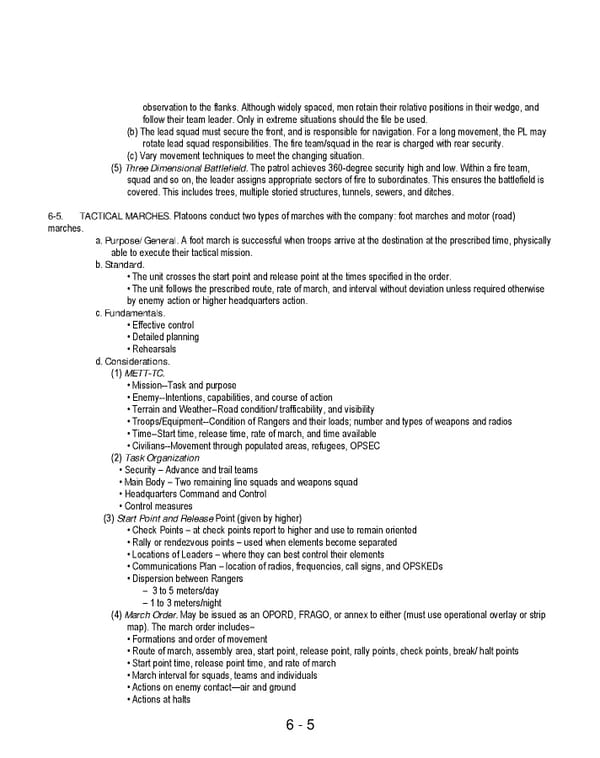6 - 5 observation to the flanks. Although widely spaced, men retain their relative positions in their wedge, and follow their team leader. Only in extreme situations should the file be used. (b) The lead squad must secure the front, and is responsible for navigation. For a long movement, the PL may rotate lead squad responsibilities. The fire team/squad in the rear is charged with rear security. (c) Vary movement techniques to meet the changing situation. (5) Three Dimensional Battlefield. The patrol achieves 360-degree security high and low. Within a fire team, squad and so on, the leader assigns appropriate sectors of fire to subordinates. This ensures the battlefield is covered. This includes trees, multiple storied structures, tunnels, sewers, and ditches. 6-5. TACTICAL MARCHES. Platoons conduct two types of marches with the company: foot marches and motor (road) marches. a. Purpose/ General. A foot march is successful when troops arrive at the destination at the prescribed time, physically able to execute their tactical mission. b. Standard. • The unit crosses the start point and release point at the times specified in the order. • The unit follows the prescribed route, rate of march, and interval without deviation unless required otherwise by enemy action or higher headquarters action. c. Fundamentals. • Effective control • Detailed planning • Rehearsals d. Considerations. (1) METT-TC. • Mission--Task and purpose • Enemy--Intentions, capabilities, and course of action • Terrain and Weather--Road condition/ trafficability, and visibility • Troops/Equipment--Condition of Rangers and their loads; number and types of weapons and radios • Time--Start time, release time, rate of march, and time available • Civilians--Movement through populated areas, refugees, OPSEC (2) Task Organization • Security – Advance and trail teams • Main Body – Two remaining line squads and weapons squad • Headquarters Command and Control • Control measures (3) Start Point and Release Point (given by higher) • Check Points – at check points report to higher and use to remain oriented • Rally or rendezvous points – used when elements become separated • Locations of Leaders – where they can best control their elements • Communications Plan – location of radios, frequencies, call signs, and OPSKEDs • Dispersion between Rangers – 3 to 5 meters/day – 1 to 3 meters/night (4) March Order. May be issued as an OPORD, FRAGO, or annex to either (must use operational overlay or strip map). The march order includes– • Formations and order of movement • Route of march, assembly area, start point, release point, rally points, check points, break/ halt points • Start point time, release point time, and rate of march • March interval for squads, teams and individuals • Actions on enemy contact—air and ground • Actions at halts
 Ranger Handbook Page 104 Page 106
Ranger Handbook Page 104 Page 106